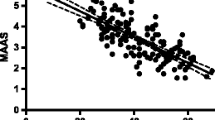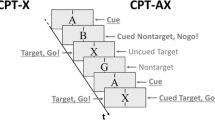Abstract
We examined the relationship between chronic procrastination, hoarding, attention deficit hyperactivity disorder (ADHD), and a computer measure of continuous performance with 84 adult patients evaluated for diagnoses. Patients were administered the General Procrastination Inventory, the Saving Inventory-Revised, the Adult ADHD Self-Report Scale and the IVA + Plus Continuous Performance Test. Procrastination scores correlated negatively with auditory attention scores, while self-reported hoarding tendencies correlated negatively with visual attention. Measures of procrastiation, hoarding, and ADHD were positively correlated. Implications and limitations of findings are discussed as well as directions for futher research.
Similar content being viewed by others
References
Adler, L. A., Spencer, T., Faraone, S. V., Kessler, R. C., Howes, M. J., Biederman, J., & Secnik, K. (2006). Validity of pilot adult ADHD self-report scale (ASRS) to rate adult ADHD symptoms. Annals of Clinical Psychiatry, 18(3), 145–148. https://doi.org/10.1080/10401230600801077.
Ayers, C. R., Wetherell, J. L., Schechter, D., Almklov, E., Golchin, S., & Saxena, S. (2013). Executive functioning in older adults with hoarding disorder. International Journal of Geriatric Psychiatry, 28(11), 1175–1181. https://doi.org/10.1002/gps.3940.
Barkley, R. A. (1997). ADHD and the nature of self-control. New York: Guilford Press.
Barkley, R. A. (2014). Executive functioning and self-regulation viewed as an extended phenotype: Implications of the theory for ADHD and its treatment. In R. A. Barkley & R. A. Barkley (Eds.), Attention-deficit hyperactivity disorder: A handbook for diagnosis and treatment (pp. 405–434). New York: Guilford Press.
Bédard, A.-C. V., Newcorn, J. H., Clerkin, S. M., Krone, B., Fan, J., Halperin, J. M., & Schulz, K. P. (2014). Reduced prefrontal efficiency for visuospatial working memory in attention-deficit/hyperactivity disorder. Journal of the American Academy of Child and Adolescent Psychiatry, 53(9), 1020–1030. https://doi.org/10.1016/j.jaac.2014.05.011.
Braintrain, I. (2004). IVA + plus continuous performance test. Richmond: Braintrain.
Brown, T. E. (2005). Attention deficit disorder: The unfocused mind in children and adults. New Haven: Yale University Press.
Ferrari, J. R. (2000). Procrastination and attention: Factor analysis of attention deficit, boredomness, intelligence, self-esteem, and task delay frequencies. Journal of Social Behavior & Personality, 15(5), 185–196.
Ferrari, J. (2010). Still procrastinating? The no-regrets guide to getting it done. New York: Wiley.
Ferrari, J. R., & Díaz-Morales, J. F. (2007). Procrastination: Different time orientations reflect different motives. Journal of Research in Personality, 41(3), 707–714. https://doi.org/10.1016/j.jrp.2006.06.006.
Ferrari, J. R., & Sanders, S. E. (2006). Procrastination rates among adults with and without AD/HD: A pilot study. Counseling and Clinical Psychology Journal, 3(1), 2–9.
Ferrari, J. R., & Sapadin, L. (2014). Procrastination. In L. Grossman, S. Walfish, L. Grossman, & S. Walfish (Eds.), Translating psychological research into practice (pp. 241–246). New York: Springer Publishing Co..
Ferrari, J., Johnson, J., & McCown, W. (1996). Procrastination and task avoidance: Theory, research, and treatment. New York: Plenum.
Frost, R. O., & Shows, D. L. (1993). The nature and measurement of compulsive indecisiveness. Behaviour Research and Therapy, 31(7), 683–692.
Frost, R. O., & Steketee, G. (2014). Introduction and overview. In R. O. Frost, G. Steketee, R. O. Frost, & G. Steketee (Eds.), The Oxford handbook of hoarding and acquiring (pp. 3–5). New York: Oxford University Press.
Frost, R. O., Steketee, G., & Grisham, J. (2004). Measurement of compulsive hoarding: Saving inventory-revised. Behaviour Research and Therapy, 42(10), 1163–1182.
Gustavson, D. E., Miyake, A., Hewitt, J. K., & Friedman, N. P. (2015). Understanding the cognitive and genetic underpinnings of procrastination: Evidence for shared genetic influences with goal management and executive function abilities. Journal of Experimental Psychology: General, 144(6), 1063–1079. https://doi.org/10.1037/xge0000110.
Knaus, W. J. (1973). Overcoming procrastination. Rational Living, 8(2), 2–7.
Lay, C. H. (1986). At last, my research article on procrastination. Journal of Research in Personality, 20(4), 474–495. https://doi.org/10.1016/0092-6566(86)90127-3.
Lynch, F. A., McGillivray, J. A., Moulding, R., & Byrne, L. K. (2015). Hoarding in attention deficit hyperactivity disorder: Understanding the comorbidity. Journal of Obsessive-Compulsive and Related Disorders, 4(1), 37–46.
McMillan, S. G., Rees, C. S., & Pestell, C. (2013). An investigation of executive functioning, attention and working memory in compulsive hoarding. Behavioural and Cognitive Psychotherapy, 41(5), 610–625. https://doi.org/10.1017/S1352465812000835.
Moreno-García, I., Delgado-Pardo, G., & Roldán-Blasco, C. (2015). Attention and response control in ADHD. Evaluation through integrated visual and auditory continuous performance test. The Spanish Journal of Psychology, 18, E1. https://doi.org/10.1017/sjp.2015.2.
Mueller, A., Hong, D. S., Shepard, S., & Moore, T. (2017). Linking ADHD to the neural circuitry of attention. Trends in Cognitive Sciences, 21(6), 474–488. https://doi.org/10.1016/j.tics.2017.03.009.
Reinhold, J. A. (2015). Adult ADHD: A review of the clinical presentation, challenges, and treatment options. Psychiatric Times, 32(10), 1–8.
Sandford, J. A., & Turner, A. (2004). Manual for the integrated visual and auditory continuous performance test. Richmond: Brain Train.
Saxena, S., Ayers, C. R., Dozier, M. E., & Maidment, K. M. (2015). The UCLA hoarding severity scale: Development and validation. Journal of Affective Disorders, 175, 488–493. https://doi.org/10.1016/j.jad.2015.01.030.
Silver, M. (1974). Procrastination. Centerpoint, 1(1), 49–54.
Slyne, K., & Tolin, D. F. (2014). The neurobiology of hoarding disorder. In R. O. Frost, G. Steketee, R. O. Frost, & G. Steketee (Eds.), The Oxford handbook of hoarding and acquiring (pp. 177–186). New York: Oxford University Press.
Solanto, M. V. (2015). Executive function deficits in adults with ADHD. In R. A. Barkley & R. A. Barkley (Eds.), Attention-deficit hyperactivity disorder: A handbook for diagnosis and treatment (pp. 256–266). New York: Guilford Press.
Tinus, T. P. (2003). The integrated visual and auditory continuous performance test as a neuropsychological measure. Archives of Clinical Neuropsychology, 18, 439–454. https://doi.org/10.1016/S0887-6177%2801%2900196-2.
Acknowledgments
We are indebted to the late Robert “Bob” Holman Coombs, PhD., Professor of Psychiatry and Bio-behavioral Sciences, University of California Los Angeles, who suggested this research area and its application for people with problem gambling.
Funding
Funding was provided by the researchers and the Institution.
Author information
Authors and Affiliations
Corresponding author
Ethics declarations
Ethical Approval
Research Regarding Human Subjects was approved from the Institution’s Human Subject’s Board.
Conflict of Interest
Authors have no conflicts of interest.
Informed Consent
Informed consent was obtained for all participants.
Rights and permissions
About this article
Cite this article
Ashworth, B., McCown, W. Trait Procrastination, Hoarding, and Continuous Performance Attention Scores. Curr Psychol 37, 454–459 (2018). https://doi.org/10.1007/s12144-017-9696-3
Published:
Issue Date:
DOI: https://doi.org/10.1007/s12144-017-9696-3




